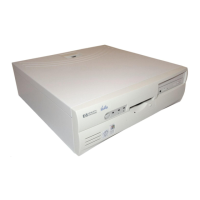Problems
About Errors at Startup 1 of 1
When your PC starts up, its BIOS performs a Power-on
Self Test (POST) to test your hardware configuration for
any problems. If a problem is detected during the POST,
an error is displayed on your PC’s monitor.
e-Buzzer
If, however, your PC is unable to display an error
message (for example, when you graphics controller has
failed), it will emit a buzzing sound. This is the e-Buzzer.
Immediately after the buzzing sound, a series of beeps
is emitted.
If you hear a series of beeps, you should count them as
this will help you detect the cause of the problem.
Number
of Beeps
Meaning
0 System OK
1 Processor absent, not correctly connected or ZIP
socket not closed
2 Power supply is in protected mode
3 No memory, bad memory modules, incompatible
memory module
4 Graphics card problem
5 PnP/PCI initialization problem
6 Corrupted BIOS. You need to activate crisis
recovery procedure (refertopage71).
7 Defective system board
Please note that for Memory (code 3), Video Card (code
4), and PnP/PCI (code 5) errors, e-Buzzer will only
detect them after a 15-second timeout.
If you miss the beep code, turn off the PC by pressing
the on/off power button for five seconds or more, then
listen for the signal again.
The e-Buzzer, as well as emitting a beep sequence, also
encodes troubleshooting information (such as the PC
models, serial number, and failing component) into a
coded audio signal. During a support call, this coded
signal can then be decoded by the HP Service Provider
to provide immediate and effective assistance.

